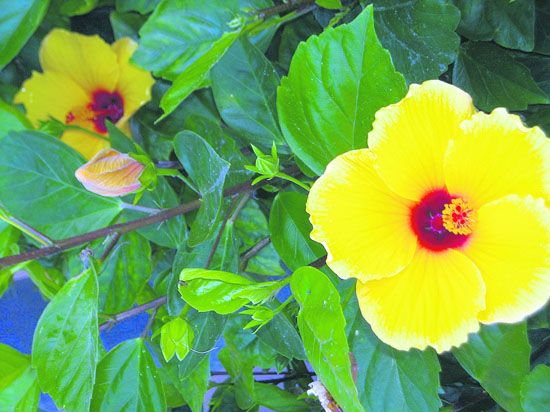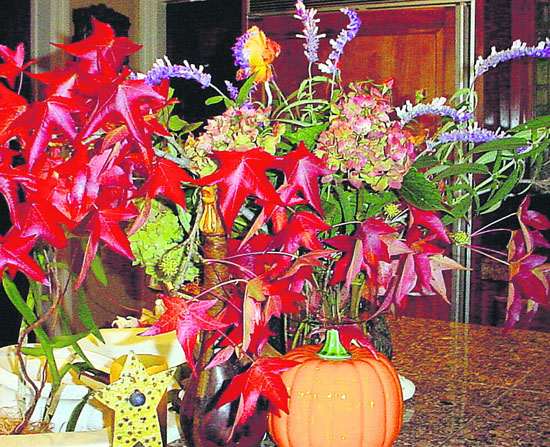
| ||||||
I am a rescue gardener and proud of it. When I see landscapers tossing perennials, bulbs, or other herbaceous materials that could easily grow in a garden, I stop to ask permission to salvage the refuse. Much to my chagrin, most developments use a landscape company to routinely pull out perfect perennials, replacing them with the latest color spots. Begonias, yarrow, primroses, asters, astilbe, daylilies, delphiniums, hosta, and a host of other valuable plants are consistently uprooted and unceremoniously discarded. Whether it's ignorance or motives of profit, why can't the spent plants be pruned back, supplemented with newer blooming specimens, and allowed their triumphant re-birth the following season? Homeowners would save money, landfill waste would be reduced, and gardens would flourish. In the least, offer the cast offs to neighboring gardeners who will rejoice at the reward of receiving these satisfying selections.
In Arizona, there is a Cactus and Succulent Society with volunteers who harvest everything from a site before it is bulldozed. As a way to save the cotillos, smaller barrels, and mammillarias for posterity, they will re-pot and sell the specimens at fairs and garden shows. The club uses the money to buy harvesting equipment, pay for paperwork expenses, insurance; and educational grants for teachers at local schools who want to organize projects related to the desert.
The Botanical Gardens at Asheville, North Carolina, have evolved over the past four decades as the result of the dedication of hundreds of volunteers who rescue all types of vegetation from destruction. In another state, a group called The Wild Ones makes an effort to save native plants that would otherwise be destroyed because of land development or re-landscaping. The positive effect is the opportunity to retrieve plants for use in another scenic environment.
If you are planning to re-landscape, consider offering unwanted plants to neighbors, garden clubs, schools, or passersby. We often see signs advertising "free wood." Why not make a sign with "free plants?" I was driving in a lovely neighborhood last year when I saw a hand made sign that read, "Free Iris-Please help yourself." Those rhizones bloomed in tricolor this past summer transforming my hillside into an oasis of beauty. Another time I noticed that a shopping center was ripping out its agapanthus to make room for other groundcover. After getting the go ahead from the demolition crew, with sharp spade in hand, I helped to dig out the plants, loaded them in my car, shared them with friends, and lovingly planted them along my fence. The next season, deep dark sapphire spikes added form and fantasy to my backyard.
Although there are no rules for rescuing plants, there is a code of ethics to follow. Here are a few guidelines if you'd like to be a savior of the natural world without breaking any laws.
1. Always ask permission.
2. Ascertain boundary lines and
observe any regulations
governing collection.
3. Do not trespass or take
additional items.
4. Do not cause any damage
to property.
5. When you are allowed to dig up
plants, fill in any holes, close
gates, and leave the property in
good shape.
6. Only take what is reasonable.
7. Plant your rescued inventory as
soon as possible or donate to a
facility or school project.
To minimize shock, place transplants in a soil medium similar to their original growing conditions, cut back blossoms and leaves at least by one third and offer some shade. The next time you are driving around, look for indications that a re-landscaping is in process, a highway is expanding, or developers are excavating. A little time, effort, sweat, and organic know how can save flora, enrich your garden, and offer survival of the species. Being a plant rescuer is a privilege! Sometimes we do need new eyes to imagine a different landscape.


“Nature gives to every time and season some beauties of its own.” --Charles Dickens
Fall is not only a great time to improve your soil but it is also one of the best times to plant a new lawn, rid your garden of weeds, implement a fresh landscape, and delight in the bountiful beauty in the changing of the seasons. When the design ends, the garden begins. A quality garden is an investment in environmental sensitivity. Although few people look forward to autumn clean up, doing the work now ensures a lasting garden for all seasons. A gardener is a crafts person of sustainability and gratitude.
• CELEBRATE the joy of Thanksgiving with family and friends with bouquets from your garden.
• HARVEST your pumpkins, squash, apples, walnuts, and tangerines now. Persimmons and pomegranates
will be ready next month.
• CLEAN UP any leaves or weeds left over from summer annuals and vegetables. Weeds that are left
standing in the fall usually come back thicker in the spring.
• COMPOST adds micronutrients and organisms that are critical and beneficial to soil and plant growth.
Chopped leaves, lawn clippings, and leafy green kitchen scraps will improve the soil texture and drainage.
• SCATTER ripe seeds of biennials and perennials, such as Foxglove and Echinacea, encouraging new plants
in your garden. Hybrid varieties may not grow true from seed.
• DEADHEAD your roses weekly to maintain blossoms and fragrance throughout the next two months. If
you prefer the red and orange colors of fall, allow the rose hips to form and harvest for additional vitamin C.
• FERTILIZE your annuals and vegetables with fertilizers high in nitrogen.
• SPREAD organic pre emergent on lawns to deter the weeds of spring.
• PULL out dandelions to add to bird feeders for extra nutrition for our feathered friends in this rainy
and colder season.
• PLANT autumn showy ground covers, trees, and shrubs as they are in their full fall riotous splendor.
A tree planted on the north side protects gardens from the blustery winter winds.
• READ Be the Star You Are! for TEENS to see how you can get your young adults interested in nature.
www.bethestaryouare.com.
• BULBS such as daffodils, Dutch iris, and crocus can be planted now. Tulips and hyacinths require
for 4-6 weeks of chilling before planting.
• SHARE divided perennials with other gardeners.
• SOW rows of onions and garlic. An old wives tale indicates that bowls of onions and garlic placed in
rooms protects against colds and flu. (Or maybe just vampires!)
• CREATE glorious cornucopias of dried roses, grasses, seedpods, branches, and reeds.
• ALLOW ornamental grasses and their feathery seed heads remain in your garden for winter interest.
• REMOVE diseased and dead branches from trees and shrubs and thin errant growth.
• FARM FRESH vegetables you’ll want to plant now are Swiss chard, broccoli, beets, carrots, cauliflower,
lettuce, peas, turnips, and spinach.
• GARDEN now for a spring time of enjoyment.
• ENJOY the fall foliage! Persimmons, pomegranates, and guava trees are now showcasing their
precious fruits. Savor the colors in anticipation of the holiday harvest.
• BECOME a rescue gardener, turning trash into treasure.
In autumn, every leaf becomes a flower, vying with real petals for the audacity of hue. Enjoy the most spectacular of seasons with foliage bursting with burgundy, maroon, bronze, gold, red, and bright yellow. Save a plant this fall and savor a healthy, happy Thanksgiving. Give thanks for the bounty that is yours.
Happy Gardening!
©2009 Cynthia Brian, The Goddess Gardener, www.goddessgardener.com
 |
Happy Gardening to You! Cynthia Brian PO Box 422 Moraga, Ca. 94556 925-377-STAR cynthia@star-style.com www.GardeningwithCynthia.com |
Reach the reporter at:
Copyright
